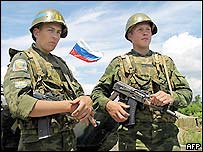
TWO-TRACK RESOLUTION — GEORGIA’S BEST OPTION ON PEACEKEEPING IN SOUTH OSSETIA
Publication: Eurasia Daily Monitor Volume: 3 Issue: 32
By:

The Georgian parliament is debating the terms of a resolution that would instruct Georgia’s government to demand the termination of Russia’s “peacekeeping” operation in Georgia’s Tskhinvali Region (South Ossetia). The parliament is acting pursuant to its October 11, 2005, resolution that had assessed this operation as contravening all international standards on peacekeeping, colluding in trans-border criminality, blocking a peaceful political settlement, directly supporting the secessionist authorities, and promoting the area’s de facto annexation by Russia. The October resolution gave the Georgian government until February 10, 2006, to report to the parliament on the Russian “peacekeepers'” ongoing performance; and, absent improvements, it reserved the right to demand the operation’s termination on the basis of international law. Parliamentary hearings with the participation of government officials and other experts since February 10 have confirmed that Russia’s “peacekeeping” performance has not improved one iota. Its conduct has, if anything, become even more brazen in South Ossetia as well as in Abkhazia (see EDM, October 6, 21, 26, 2005, February 7, 2006).
Thus, on performance as well as on legal grounds, Georgia would be fully within its sovereign rights to demand the termination of Russia’s military presence on legally recognized Georgian territory in South Ossetia. That presence is itself a legacy of Moscow’s assault on Georgia during the final Soviet and initial post-Soviet years. It is also a major aspect of Russia’s continuing effort to prevent international law and security from taking hold in the South Caucasus. The parliament’s October resolution had said, in effect, that enough is enough. The follow-up resolution now under consideration can say no less. Its content can also help awaken some international officials out of a long-standing complacency on this and related peacekeeping issues.
A two-track resolution would best serve Georgia’s interests locally and would maximize the international credibility of Tbilisi’s demarche. Its first track can, as it must, demand an end to the 13-year-long “peacekeeping” farce in South Ossetia. The demand would flow naturally from a summary of the Russian operation’s track record in the resolution and a listing of Russian and secessionist ongoing activities under the Russian military’s shield. The October resolution and the parliamentary hearings just held have laid ample groundwork for the upcoming resolution’s first track.
The second track would be equally important in terms of suggesting alternative solutions, enlisting international support for these, and defusing the Kremlin’s attempts to misrepresent Georgian initiatives as reckless. Such attempts are ongoing both in Washington and, especially, in Western Europe. A Georgian pledge of non-use of force would be helpful in this regard.
The resolution’s second track could include an emphatic appeal to the international community to help transform this “peacekeeping” operation into genuine peacekeeping. The goal is not simply to remove Russian troops but also to organize within a short time-frame a substitute operation, in line with international peacekeeping standards, and conducive to a political settlement in the interest of Georgia and the local population. That time frame need not be specified in terms of a deadline, but the sense of urgency must be conveyed.
Such an operation should be not only internationalized but also largely civilianized, shifting the emphasis from military to civilian elements. Civilianization of peacekeeping would correspond to Georgia’s and the international community’s goal (nominally declared by Moscow as well) of de-militarizing the security zone and South Ossetia as such.
In this regard, the resolution can appeal to the European Union to support international peacekeeping in South Ossetia based on the EU’s recently developed ideas. These include an emphasis on civilian components of the peacekeeping contingent, such as police and other law-enforcement elements, with a comparatively small number of troops. First adumbrated in a 2003 proposal from Javier Solana’s office regarding Moldova, the EU’s peacekeeping concept has since then undergone its first tests in the Balkans and elsewhere. Its application in South Ossetia could signify a major (and much needed) success for the EU’s common foreign and security policy.
The text’s second track could helpfully include a reference to the political settlement proposals, submitted by Georgian Prime Minister Zurab Nogaideli and South Ossetian de facto leader Eduard Kokoiti, in the latter part of 2005 (see EDM, November 23, December 6, 2005). These sets of proposals include both compatible and incompatible elements that are seen as negotiable. While reaffirming Tbilisi’s commitment to negotiations, the resolution must not link the transformation of peacekeeping and the political negotiations in terms of timetables. Any attempts at harmonizing the respective plans could (if considerable experience is any guide) drag out for a long time. However, transformation of the existing “peacekeeping” is the most urgent priority, not least for giving political settlement negotiations a chance.




